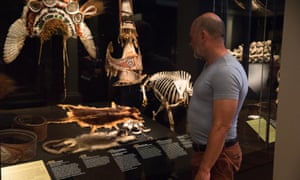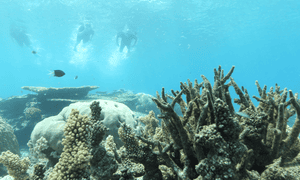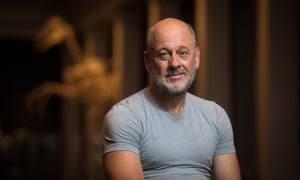The author and scientist, who has returned to his roots at the
Australian Museum, says the world is about to see a major shift towards
climate action
Tim Flannery
laments that young Australians today will never be able to experience
in the same way the natural wonders he enjoyed in his youth.
He grew up in Melbourne on remnants of the sandplain flora, “one of the great floristic gems of Australia,” he says. Once smothered in flowers in springtime, it has now largely been lost through development and altered burning regimes. Flannery, 63, spent his youth swimming and scuba diving in northern Port Phillip bay, which he says is now also gravely deteriorated.
He further points to the Great Barrier Reef, which suffered
unprecedented mass bleaching in 2016 and 2017 and the “serious
questions” about whether it can now be saved.. “Something like 70% of
the reef that was there a century ago is now dead,” he says.He grew up in Melbourne on remnants of the sandplain flora, “one of the great floristic gems of Australia,” he says. Once smothered in flowers in springtime, it has now largely been lost through development and altered burning regimes. Flannery, 63, spent his youth swimming and scuba diving in northern Port Phillip bay, which he says is now also gravely deteriorated.
But without detailed records on species distributions, it’s impossible to map the losses due to climate change, explains Flannery, who recently returned to the 192-year old Australian Museum in Sydney, where he was principal mammalogist from 1984–1999.
Rather than being “a fusty old relic” the museum is playing a vital role in this, he says. “The collections that say where things were, and when, are here – and that’s the most important asset we’ve got to understand the response of biodiversity to climate change … The people of New South Wales need to understand what a valuable asset they have.”
"We can claw back some of the damage [from climate change]. We will go through 2C, but hopefully come out the other side"
Flannery – who has named more than 30 new mammals over his career and was the Australian government’s climate commissioner from 2011–2013 – relocated to Sydney in January for the year-long role as a distinguished research fellow. This position, as the museum’s de facto climate change ambassador, was funded by anonymous private donors.
While species loss is heartbreaking, Flannery says what keeps him awake at night worrying are the human impacts.
“Global hunger has increased for the last three years because of extreme weather events, and that follows many decades of improvement,” he says. “To see that going backwards is terrifying, quite frankly. Nothing is more important than global food security.”
Bringing attention to the plight of those suffering the effects of climate change, such as Australia’s Pacific Islander neighbours, is one of a series of goals he has set for his time at the museum.

Inadequate action by governments has been brought into focus by ever-more alarming reports about the rate of warming, such as the recent long-term forecast from the UK Met Office that we might temporarily exceed 1.5C of average warming over pre-industrial levels in the next five years.
Preventing warming from exceeding 1.5C in the long term was one of the targets agreed by the world’s nations in the UN’s 2015 Paris agreement.
“Sadly, I’ve been aware of [the urgency of] this for a long time,” says Flannery, who believes that breaching that threshold is inevitable in the next few decades, and that we are probably already committed to 2C of warming, “which is towards the catastrophic end of things”.
Instead of getting “dismayed and depressed”, he suggests we focus on damage that’s still within our power to avoid. “We have to reduce emissions as hard and fast as possible… [and] develop technologies that will get gigatons of carbon dioxide out of the air by 2050.”
Technologies to remove carbon dioxide from the atmosphere – such as giant seaweed farms and processes to accelerate weathering of silicate rocks – have been a focus of his of late. “We can claw back some of the damage. We will go through 2C, but hopefully come out the other side.”
While the debate over the science of climate change is long settled in Europe, political inertia has dogged Australia and the US, which notably pulled out the Paris accord following the election of Donald Trump.
But Flannery sees a shift in the air – particularly in the wake of climate-linked disasters including the mass bleaching events; mass fish kills on the Darling River; and droughts, heatwaves and bushfire seasons that are all increasing in duration and intensity.
“The speed and scale of impacts have been something that is really shocking,” says Flannery, who was on the Australian Academy of Science’s expert panel investigating the Darling River fish kills, and which this week laid the blame on the Murray-Darling Basin Authority for ignoring scientific advice and the threat from climate change.
“People are shocked, but … they should be angry,” he adds. “The consequences will grow year by year, and stuff we were warning people about 20 years ago is now coming to fruition and is impossible to deny, unless you are wilfully blind.”
“Bullshit baffles brains, but only temporarily and we’ve gone through a period in Australia and the US where people have been able to lie … But we’re in a different world now, a world where people are living with climate change consequences, and bullshit is no longer baffling brains, and so we are about to see a big shift.”
One transformation he’s seen is farmers changing from being deniers to advocates for action. “People see extreme weather events and don’t just think this is an odd occurrence, they see it as part of the longer-term trajectory of change that’s going to bring about more and more adverse consequences unless something is done,” he says.
This week the Australian government formally noted the world’s first species to suffer extinction at the hands of climate change – the Bramble Cay melomys, a Torres Strait rodent that washed away in a storm surge caused by rising sea levels.
Australia’s museums have a critical role to play in research and keeping collections and records that inform us about species such as this, so we can map changes and losses.
Despite this, a lack of investment has plagued many of our museums, including the Australian Museum, which put a freeze on capital expenditure in December to help cover costs of renovations to take larger touring exhibits, including one on Tutankhamun, slated for 2021.
Research staff numbers have fallen here and at other museums in recent decades “but the sort of skills that museums specialise in have never been more needed,” says Flannery, who was also previously the director of the South Australian Museum.
Examples of crucial records held at the Australian Museum include that there were once “rock wallabies on Middle Head, rufous bettongs at Rose Bay and – until the 1970s – eastern quolls at Vaucluse, the last colony on mainland Australia,” Flannery says.
He now hopes to muster the power of citizen scientists to gather data on the effects of climate change on the New South Wales environment. “Looking at the timing of when things happen – when plants bloom and when insects pupate … is one of the best ways of measuring climate change, and people can do it in their gardens,” he says.


No comments:
Post a Comment